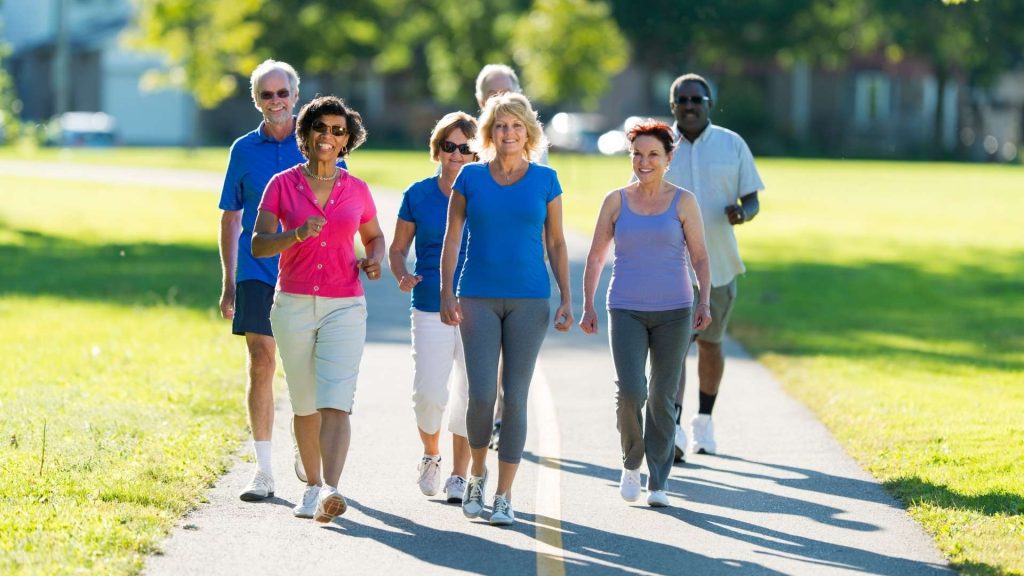“It is well established that physical activity is an efficient strategy for successful aging.” 1
Why is a walking program recommended as we age?
Starting and sustaining a walking program is a safe and effective form of exercise for most people. Walking for fitness has many health benefits and is a great choice for physical activity regardless of age. As we get older, beginning and continuing to walk for fitness can have significant positive outcomes. Participating in a walking exercise program has the potential to help seniors decrease their risk of disability and increase their likelihood of maintaining independence.2
Research has shown that compared with those who are inactive, seniors (≥ 60 years) with low, medium, and high activity levels had a 22%, 28%, and 35% lower risk of death, respectively.1,3 In addition, this same research showed that starting or restarting physical activity during retirement could reduce the risk of death by two-thirds, while any reduction in physical activity – even among those with the lowest levels of physical activity – can expose seniors to a higher risk of death.1,3,4
In other words, for positive health outcomes among seniors –
- If you haven’t been exercising, just begin
- If you’ve stopped exercising, start again
- If you’re already exercising, adding more likely has added benefits.
How much walking for seniors?
So, how much exercise should seniors be getting? National guidelines recommend 150 minutes of moderate-to-vigorous physical activity (MVPA) a week.5 That’s equivalent to 30 minutes of brisk walking 5 days a week. Additionally, the guidelines denote that when seniors cannot do 150 minutes of MVPA a week because of chronic conditions, they should be as physically active as their abilities and conditions allow.5
Furthermore, research suggests that even exercise of shorter duration and lower intensity has life expectancy benefits for seniors.1,3 Participating in physical activity 15 minutes a day 5 days per week, even at lower intensity, has shown to significantly reduced mortality among older adults.1,3 Thus, recommending a 15-minute walk, preferably a brisk walk, 5 days a week can be a good first goal for getting seniors active.4
Consider the Following to Start Walking and Stay Safe and Motivated:
1. Talk with your doctor before you begin.
Most individuals can safely walk for exercise. Discuss any conditions that may act as barriers and how you might work around them. Discuss any medications that you are taking and their side effects (e.g., dizziness, fatigue, or nausea) that may slow your activity progress. Often, treatments and medications can be changed or modified by your health care provider to help you stay as active as possible.
2. Start slowly.
Some muscle and joint stiffness after exercise is normal, and your body will usually adapt to this over time; but if the discomfort persists, talk with your doctor.6 If you’re not feeling well, due to a cold, flu, or other illness, wait to exercise until you’re feeling better. If you miss more than two weeks of exercise, be sure to start slowly again.6
3. Stay hydrated.
Drink water before, during, and after exercise, even if you don’t feel thirsty.6
4. Wear the right shoes and clothes:
- Choose comfortable, properly fitted athletic shoes with good arch support and a cushioned heel to absorb shock.6 If you have foot problems, check with your health care provider who may be able to recommend orthopedic shoes.7
- Choose clothes made of moisture wicking fabrics and which allow movement without constraint.6,F
5. Aim for the right pace.
Try to walk as fast as you can while still being able to chat with a friend.7 You should be able to talk, but not sing.
6. Don’t let a cane or walker stop you!
These assistive devices can improve your balance and take the load off painful joints.7 If you don’t use a cane or walker, consider Nordic poles, which can give you more stability, and help to burn more calories by activating all the muscles of the upper body.8
7. Stop and talk to your doctor if you have any of the following symptoms while exercising:
- Chest pain or pressure
- Trouble breathing or excessive shortness of breath
- Light-headedness or dizziness
- Difficulty with balance
- Nausea.6
8. Join a walking program or walk with a friend for motivation, accountability, and safety.
Whether you’re in the 60+ age group or you work with or have a loved one that is, starting a walking program is a great way to begin adding activity to your day, and can be a simple, and safe way to remain active and functional as you age.
- Hupin, V. Pichot, M. Garet, P. Edouard, J. Raffin, M. Berger, L. Féasson, J.C. Barthélémy, F. Roche. Fifteen minutes daily physical activity may be a new best target in older adults: The proof cohort study. Annals of Physical and Rehabilitation Medicine, Volume 61, Supplement,2018, Page e102. Doi 10.1016/j.rehab.2018.05.218.
- Fahmy, S. “Study: Regular walking nearly halves elderly disability risk.” UGA Today. 15 July 2018. https://news.uga.edu/study-regular-walking-nearly-halves-elderly-disability-risk/. Accessed September 9, 2022.
- Hupin D, Roche F, Gremeaux V, et al. Even a low-dose of moderate-to-vigorous physical activity reduces mortality by 22% in adults aged ≥60 years: a systematic review and meta-analysis. British Journal of Sports Medicine 2015;49:1262-1267. Doi 1016/j.rehab.2018.05.218
- European Society of Cardiology. Exercise, however modest, found progressively beneficial to the elderly. 15 May 2015 https://www.escardio.org/The-ESC/Press-Office/Press-releases/Exercise-however-modest-found-progressively-beneficial-to-the-elderly. Accessed September 9, 2022.
- S. Department of Health and Human Services. Physical Activity Guidelines for Americans, 2nd edition. Washington, DC: U.S. Department of Health and Human Services; 2018.
- American Academy of Family Physicians. Exercise and Seniors. May 2022. https://familydoctor.org/exercise-seniors/. Accessed September 7, 2022.
- AGS Health in Aging Foundation. June 2019. https://www.healthinaging.org/tools-and-tips/tip-sheet-walking-older-adults. Accessed September 7, 2022.
- Harvard Medical School. Fitness Trend: Nordic walking. June 29, 2022. https://www.health.harvard.edu/exercise-and-fitness/fitness-trend-nordic-walking#. Accessed September 8, 2022.





